#maria sophia von erthal
Text
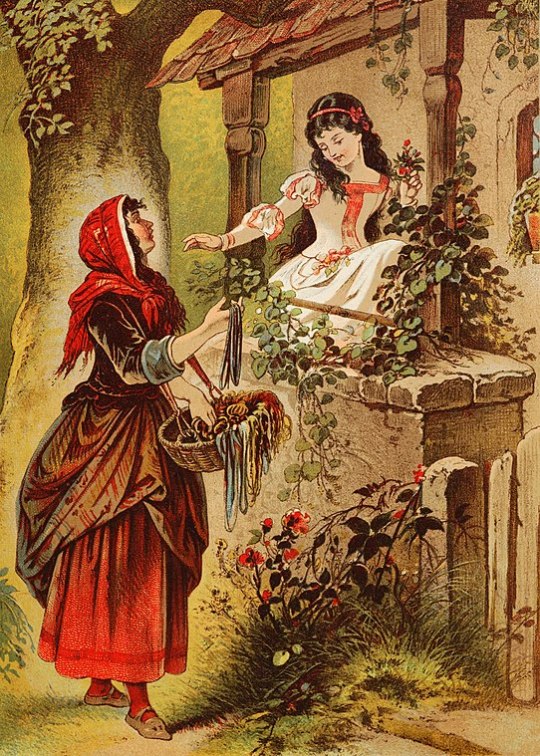
The true Snow White was María Sophia Von Erthal (b. 1725).
#snow white#snow white and the seven dwarfs#real snow white#once upon a time#grimm#maria sophia von Erthal
2 notes
·
View notes
Text
Was Snow White a Real Person? History of a Folktale
Recently I’ve examined two (deeply flawed) theories about historical women who were supposedly “the real Snow White.” This month, I’m trying a different approach: tracing the story as far back as I can. Might the fairy tale of Snow White be even older than we realized?
Read more
11 notes
·
View notes
Text
I always asked myself why Snow White's Storybrooke name was Mary Margaret as it has no double meaning like Ruby or Regina (queen in Latin). The two historical characters who supposedly inspired the Brothers Grimm to write down the fairytale as we know it:
Margaretha von Waldeck
Maria Sophia Margarethe Catharina von Erthal
I love finding these things!

32 notes
·
View notes
Text
In Search of Snow White: Real-Life Origins
🍎 In Search of Snow White: Real-Life Origins 🏰
Welcome to our enchanted journey into the real-life origins of Snow White! Join us as we unravel the dark history behind this beloved fairy tale, exploring the chilling tales of Maria Sophia von Erthal and Margaretha von Waldeck.
🔍 Dive deep into the original Grimm Brothers’ rendition and discover the gruesome details hidden within the pages of…
View On WordPress
0 notes
Text
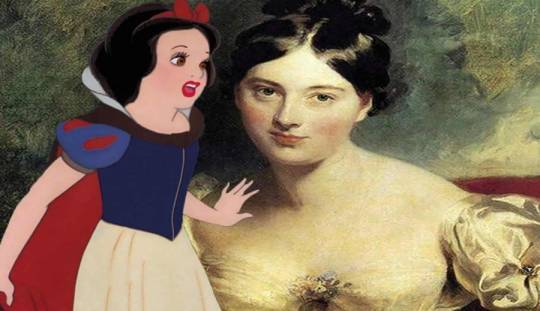
#SapiensDisney 3️⃣3️⃣
In 1986 Karl Heinz Bartels published a book in which he theorized that Snow White was inspired by a real-life character.
According to the author, in 1725 in Lohr, near Frankfurt, Princess Maria Sophia Margaretha Catharina von Erthal was born.
Maria actually had a stepmother who managed to drive her out of the palace, forcing her to take refuge among the malnourished local miners.
It is hypothesized that the apple was poisoned with nightshade, ironically very common in those areas.
Among the memorabilia still admirable in the castle today is a talking mirror, an expensive acoustic toy of the time which is said to have been given to the stepmother by the groom.
📚 Source
🦄 Sapiens³
#SapiensDisney 3️⃣3️⃣
Nel 1986 Karl Heinz Bartels pubblicò un libro in cui teorizzava che Biancaneve sia ispirata ad un personaggio realmente esistito.
Secondo l'autore, nel 1725 a Lohr, nei dintorni di Francoforte, nacque la principessa Maria Sophia Margaretha Catharina von Erthal. Maria ebbe effettivamente una matrigna che riuscì a scacciarla da palazzo, costringendola a rifugiarsi tra i malnutriti minatori locali. Si ipotizza che la mela sia stata avvelenata con della belladonna, ironicamente molto comune in quelle zone.
Tra i cimeli ancora oggi ammirabili nel castello è presente uno specchio parlante, costoso giocattolo acustico dell'epoca che si dice fu regalato proprio alla matrigna dallo sposo.
📚 Fonte
🦄 Sapiens³
0 notes
Text
Dating Disney: Snow White

I was planning on doing Tangled next, but someone requested Snow White in my Beauty and the Beast post, so I’m nothing if not accommodating. The general consensus is that this movie is set in about the 1550′s in Germany, but let’s pick the film apart and see what happens.
To begin with, we need to know where the story comes from, and no, I’m not talking about the Brothers Grimm in 1812. No, the Brothers Grimm didn’t write any of their own stories. They wrote down the German versions of folk tales that they heard. Some, like Sleeping Beauty and Little Red Riding Hood came from foreign countries with their own German variations, but Snow White is an unusual exception, because she’s not only completely German, she’s very likely a real person.

Maria Sophia von Erthal
Maria was born June 15, 1729, in Lohr am Main, Bavaria to Prince Philipp Christoph von Erthal and the Baroness von Bettendorff. Her mother passed away in 1741 and her father remarried two years later on May 15, 1743 to Claudia Elisabeth Maria von Venningen, Countess of Reichenstein. The magic mirror also appears, as a gift from Philipp to Claudia after they were married. A talking mirror created in 1720 still hangs in the very castle where Maria lived, now a museum. Claudia reportedly had little love for her stepchildren, and Maria was no exception. She preferred her children from her previous marriage. Maria had a bit of a reputation in the town of Lohr, as she was so kind and generous that many of the townsfolk claimed she was a fairy to be so kind. The Spessart forest grew nearby, and on the other side is the town of Bieber, where much of the mining jobs were done by children, since their small bodies were able to get through the mines much easier. Maria eventually died of unclear circumstances, but it’s theorized that she was poisoned with deadly nightshade, Atropa Belladonna. Fans of Film Theory may recognize that name as the very poison Matpat theorized is what Queen Grimhilde used on Snow White in the movie, so it seems we’ve come full circle.
Clothing

That stiff upright collar being worn by Snow White in the film came into vogue during the reign of Queen Marie de Medici of France (1600-1642). The fan collar is extremely closely tied historically to this queen, and the style is even named for her. So, based on the fact that Marie de Medici must have at least been Queen Consort beginning in 1600, we must assume that the film takes place in the 17th century. So, we’re one step in and already the standard mid 1500s setting is being debated.
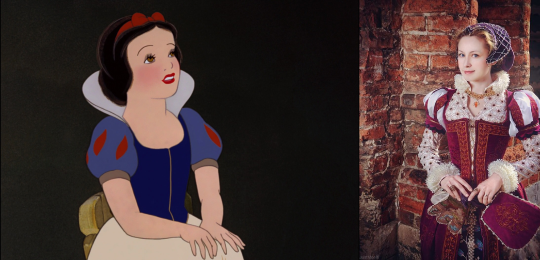
Those aren’t just red splotches on Snow White’s sleeve, what we’re seeing is a paned sleeve, when panels of fabric would be worn over another layer of fabric, usually of different colors, creating stripes of color. This style was popular during the 16th and 17th centuries.

The dwarves are dressed rather plainly, with simple tunics or shirts, tights, soft hide shoes, and simple caps. The only outlier is their fine metal buckles, but belt buckles have been found dating back to the Celts of the 5th century, so I won’t get up in arms about what specific era these specific belt buckles should be from.

Both Snow White and Queen Grimhilde are rocking some killer heels, but high heels as we know them today emerged as a trend of the 1700s, or the 18th century. While there were high heels earlier, with there even being an ordinance in 1430 that heels could not exceed 3 inches, the modern high-heel, which they both seem to be wearing, emerged later.
Technology
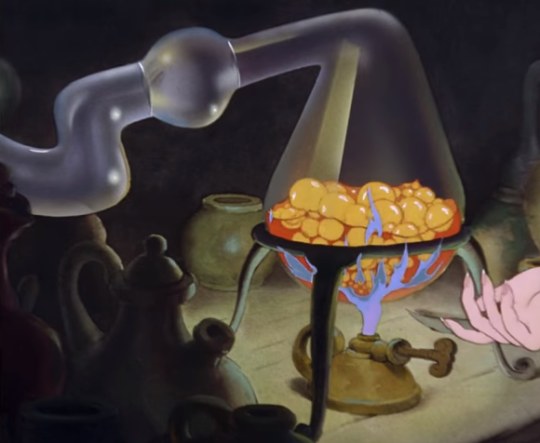
Correct me if I’m wrong, but, that looks like a bunsen burner to me. At the very least, it’s gas technology. Gas technology we did not have until 1852.

The dwarves seem to own a pump organ, first invented by Christian Gottlieb Kratzenstein in 1780.

The kinds of eyeglasses supported by the ears are seen as early as 1600 in this portrait of Cardinal Fernando Niño de Guevara.

During “High Ho” we see Doc using a loupe to examine diamonds. These handsfree magnifying glasses have been around since 1250, used primarily by Jewelers and Watchmakers.
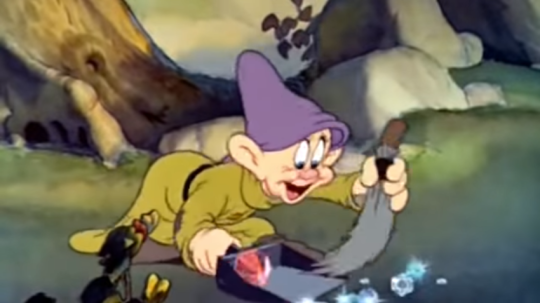
The first dustpan was invented sometime around the 1850s before a more well-designed dustpan was invented in 1897.
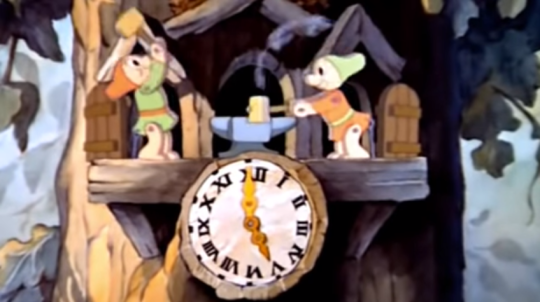
What we see here is a variation of a cuckoo clock, replacing the hooting bird with mechanical figures on a track. While I couldn’t find if this is a specific type of Cuckoo clock, I did find that the Cuckoo clock was invented in roughly the mid 18th century near the Black Forest in Germany.
Conclusion

And I thought Mulan was going to have problems, this movie has no idea when it’s supposed to be set. The clothing is from the 1600s and 1700s, but there’s technology that’s almost modern. I will give the movie a pass because it’s the first animated movie ever, but in terms of figuring out a time period, it’s a bit of a headache. I’m just going to have to go with the general vibe of the setting and say we’re looking at about the middle of the 1600s with advanced technology courtesy of the metalworking dwarves because the technology is the primary outlier that throws off the era of the film. Considering most of the advanced technology in in possession of the dwarves, I’m willing to hand-wave it as dwarven magic.
Setting: Lohr Am Main, Bavaria
Kingdom: Holy Roman Empire (962-1806)
Year/Era: Renaissance, mid 17th Century
Language: Early New High German (1350-1650)
#dating disney#snow white#snow white and the seven dwarves#happy#dopey#grumpy#doc#sneezy#bashful#sleepy#queen grimhilde#evil queen#prince florian#renaissance#holy roman empire#bavaria#lohr#lohr am main#maria sophia von erthal#claudia elisabeth maria von venningen#marie de medici#paned sleeve#fan collar#cuckoo clock
711 notes
·
View notes
Text
The REAL Story Behind The Crooked Man And The 7 Other Fairy Tales & Nursery Rhymes With *Even More* Disturbing Backstories
It was 4 years ago that we first met the Crooked Man.
With a *sickening* reveal via rottweiler fit for the latest season of Rupaul’s Drag Race, the suited gentleman staggered his way from The Conjuring 2 (2016) into our nightmares.
But his ashy undertones, gnashing teeth, and general aura of “I’m a demon, or something, which means I have no real motive apart from wanting to kill you” isn’t the only thing that fits the film far too well.
The Conjuring universe is the definition of ‘based on a true story’. And the Crooked Man fits the brief.
In the opening scenes of the film we see lovable and bulliable Billy stutter through a nursery rhyme:
There was a crooked man, and he went a crooked mile,
He found a crooked sixpence against a crooked stile;
He bought a crooked cat, which caught a crooked mouse,
And they all liv'd together in a little crooked house.
Accompanied by a totally-cursed-i-mean-just-look-at-it zoetrope (it’s a bit like a mini projector that shows you a moving cartoon), Billy introduces us to one of the handful of extra entities terrorising London’s most haunted house. You can discover more about the true story of 284 Green Street which inspired The Conjuring 2 here.
But Billy also introduces us to a real nursery rhyme inherent in British culture - and British history.
Yes, the nursery rhyme, like many, is based on dark and twisted reality softened for a bedtime story. And amongst this history was a real person. Unfortunately, the Crooked Man is not the only fairy tale monster or nursery rhyme entity that will be haunting your dreams.
Are y’all tucked in?

The Crooked Man
The nursery rhyme was first told sometime in the 17th century during the reign of King Charles I. But the Crooked Man was not the Stuart King - it was allegedly inspired by Scottish general Sir Alexander Leslie and the covenant he signed.
The covenant secured religious and political freedom for Scotland despite prevailing animosity between the English and the Scottish.
The crooked stile is the awkward alliance between the two parliaments and the crooked house refers to the collective union the Scottish and English lived together in. But the ‘crooked’ part works on another level, too.
The great recoinage of late 17th century meant sixpences - which feature in the rhyme - were made of very thin silver and thus easy to bend.
An alternative origins story links it back to Lavenham, a village in Suffolk (England). The half-timbered houses leaned at off angles as if supporting each other, creating a crooked aesthetic that matches the nursery rhyme.
The Pied Piper Of Hamelin
I distinctly remember hearing the story of the Pied Piper when I was about 7 years old. I was there, sat crossed-legged on the wooden floor in assembly and listening to the headteacher tell us the tale of the musical maverick with an overhead projector.
I remember it being far more nostalgic and not so traumatising.
The story goes that sometime in the 13th century a peculiar man dressed in brightly-coloured clothes (pied clothing) was hired by the town to rid them of the rats with his pipe-playing abilities. Hamelin had been suffering from an infestation that would threaten the locals with the plague. The piper was to play his pipe, entice the rats with his magical music, and lead them to a river where they would promptly drown.
He was hired and he did the job - but they didn’t pay up.
The piper couldn’t exactly refund his services. Instead, he sought vengeance, luring away the children of the town with his magical pipe. He waited until Saint John and Paul’s day where the adults would be in the church, dressed in green like a hunter, and played his pipe. The children of the village swarmed to him, all 130 of them, following him out of the town and into a cave. Three were unable to follow due to being blind and deaf and thus told the villagers what had happened.
The real story:
Some versions of the story claimed he made them walk into a river, others claim he returned them after payment. But what we do know for sure is that there is a street in Hamelin called Bungelosenstrasse. On this street - ‘the street without drums’ according to translation - the children were seen last. No music and no dancing is allowed on this road.

Bluebeard
We open on a typical Medieval scene: a powerful and wealthy man is looking for a young wife to replace the last one who mysteriously went missing. Bluebeard’s been through quite a few women, actually, but it’s his latest bae that stars in this story. Bluebeard marries his neighbour’s daughter and goes on a business trip.
He tells her he can stay alone in their house but she cannot open a certain door.
Of course, she opens the door and finds the corpses of his ex-wives. Her and her sisters band together to kill Bluebeard, showering themselves with a wealthy inheritance.
The real story:
This tragic tale of murder and mystery is unfortunately all too true.
There are many alleged origins of the folktale. Let’s start with the Medieval ruler of Brittany, Conomor the Cursed: his new wife agreed to marry him to prevent him from invading her father’s lands but accidentally walked in on a room full of his dead, old wives. She was visited by their ghosts who warn him if she falls pregnant, he will kill her, preventing a prophecy that claims he will be killed by his own son.
She gets knocked up, gives birth, and then she gets her block knocked off.
An alternative inspiration could be a similarly brutal figure: Gilles de Rais (15th century). He was accused of murdering approximately 140 children who suddenly went missing in the Nantes countryside. He was condemned to death and executed in 1440.
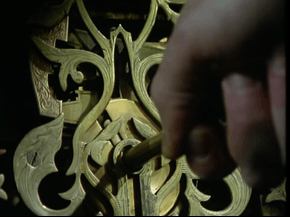
Snow White
It’s one of the most popular fairytales of all time.
The story goes that a queen gives birth to a baby girl but dies in childbirth. The king’s new wife is wicked and vain, asking her magic mirror ‘who is the fairest one of all?’ on a daily basis. When the child turns seven, the mirror changes its answer from the queen to the child, Snow White (yeah, that’s weird). The queen hires a huntsman to kill Snow White, but she begs for mercy and says she will live in the woods and he can pretend he killed her.
She finds shelter in a cottage belonging to seven dwarfs who agree to let her stay as a maid until the evil queen asks the mirror her favourite question. It claims Snow White is still alive and the fairest of them all. She goes through several methods of attempting to kill Snow until she falls into a deep coma. The dwarfs host a funeral, a prince comes along, and he, uhhh, kisses what he assumed to be a corpse and she is awakened.
They then get hitched but don’t invite the queen to the wedding. The queen asks the mirror yet again the identity of the fairest, assuming Snow is well and truly deceased but the mirror breaks the bad news to her again. The queen tries to kill her once more but Snow’s hubby forces her to wear red-hot iron slippers and dance in them until she dies.
There’s a lot going on here.
But rather than unpacking everything that's wrong with all of this *gestures to everything*, let’s just get to the dark reality beneath it all.
The real story:
The inspiration is generally deemed to be Margaretha von Walbeck, a young woman who had a terrible relationship with her stepmother. She was forced to move to Brussels and fell in love with Phillip II of Spain, a romance not popular with her parents.
Suddenly, however, Margaretha died. Rumour has it she was poisoned.
Another detail of her life also links her to Snow White: her father’s copper mines were often filled with child labourers whose growth was stunted by working in them, mirroring the ‘dwarves’ in the story.
But Margaretha is not the only contender: Maria Sophia Margaretha Catharina Freifräulein von Erthal *inhale* also hated her stepmother. This - and the fact that her stepmother was given a mirror as a gift by her husband - also ties her to Snow White.

Hansel And Gretel
It’s possibly the most simple fairy tale up for discussion: a brother and sister are sent out to the woods by their father. The mother asked for him to send them away so they can survive a famine. But Hansel uses stones to trace their steps back home. One day, however, he uses crumbs. They get eaten by the local wildlife, so the kids get lost.
They then discover a witch's house, a gingerbread cottage. She lures ‘em in, fattens up Hansel, and prepares to feast on his flesh. The kids plot against her, throw her in the oven, and steal her stuff before heading back to live with their father.
Okay, so maybe this one isn’t based on a true story. It’s based on true stories. Yep - plural.
The real story:
Child abandonment and infanticide was pretty common during plagues, famines, and all other circumstances of poverty. In fact, this particular tale is believed to come from the Great Famine which stretched across Europe from 1315 to 1317. Child abandonment surged during this time.
Rapunzel
Turns out Disney lopped off a lot of Rapunzel’s real story to make it a family friendly movie. Yep, this is a weird one.
A pregnant woman begins to crave a kind of salad leaf (Campanula rapunculus, also called rapunzel) in the garden of the house next door. He goes out to nick it but is caught by the homeowner - a witch. She says he can take the rapunzel, but in return he must give her the child once it is born.
The witch raises Rapunzel as her own but locks her away in a tower when she is 12 to protect her from the outside world.
A prince eventually rocks up and decides to climb her immensely long hair. Unknown, probably PG-13 and probably not consensual acts happen. Still, given it's the medieval era they agree to get hitched after escaping.
The witch discovers her plan, cuts off her hair, exiles Rapunzel, and uses the locks as bait for the prince before throwing him to the briar roses below where he is promptly blinded. Rapunzel gives birth to twins and the prince finds her, identifying her only by her voice. Her tears restore his voice.
The real story:
Being kidnapped or being kept hidden away from the rest of the world is pretty common, well, all of the time. But Saint Barabara, a Greek saint, was the main inspiration for the tale.
She was locked away in a tower in Turkey in the third century by her father in an attempt to protect her Christianity. But her Pagan father’s efforts did not succeed and she discovered the ways of Jesus. She escaped but she was eventually caught by her father who then tortured and beheaded her.
Religious intolerance, y’all.

Beauty And The Beast
Time for another Disney classic with a heavily edited plotline.
The father of a family seeks shelter in a grand palace during a storm. In the morning before he leaves he takes a rose from the garden but is caught by a beast who threatens to kill him for nicking a flower. But the beast agrees not to kill him if his daughter takes his place instead.
The daughter moves to the palace but asks to go see her family for a week. She is then convinced by her sisters to stay at home. A magic mirror then reveals the beast is dying because she isn’t with him. She returns to him and her love breaks the curse that makes him appear so monstrous.
The real story:
Petrus Gonsalvus (1637-1618) was born with hypertrichosis. This meant he had a thick layer of hair all over his body - his physical difference didn’t go down very well. He was kept as a ‘wild man’ in a cage and fed raw meat.
When he was 10 years old he was gifted to the king of france. But he wasn’t kept as a ‘beast’. He was educated like a nobleman and was taught to read, write, and speak three different languages. He was then married off to the daughter of a court servant.
He was married to her for over 40 years and they had seven children together.
(Aww.)
Three Blind Mice
Three blind mice, three blind mice,
See how they run, see how they run,
They all ran after the farmer’s wife,
Who cut off their tails with a carving knife,
Did you ever see such a thing in your life,
As three blind mice?
The real story:
It's one of those nursery rhymes you grow up with - and 17 years later you realise how traumatic it actually is.
This nursery rhyme can be traced back to the reign of Bloody Mary (16th century) who had a tricky relationship with Protestants. And by that I mean she burnt them alive, hence the nickname.
The three blind mice represented three Protestant bishops who may have been blinded before their execution or spiritually blind for following Catholicism. Another reference to Queen Mary was her as a farmer’s wife.
Her husband, Philip of Spain, owned several estates and thus was technically a farmer.

Welp, there goes your childhood.
If you liked this post go on and like and reblog. Go on, share your love for my amazing talents with the world!
And if you want to read an article about the paranormal every weekend then you best be hitting follow!
See you next week, kiddos. Sleep tight.
#crooked man#the crooked man#the conjuring#conjuring 2#the nun#valak#the crooked man movie#fairy tales#grimm#fairytales#origins of fairy tales#nursery rhymes#scary stories#ghost stories#true ghost stories#based on a true story#Ed and Lorraine Warren#folklore#urban legend#creepy urban legends#paranormal#supernatural#the conjuring 3#Horror Movies#horror#best horror movies#disney#dark fairytale#nostalgia#history
40 notes
·
View notes
Note
Would the Magic Mirror in Snow White be considered Fae?
The original concept of a mirror which could show you secrets is very old. The Greeks had a ceremony where a mirror was dipped in sacred water and might show you glimpses of things the gods allow. A sort of divination. The Chinese and Japanese had myths about such objects as well. Most stories about mirrors don’t involve the mirrors we know of today because it was really hard to make such mirrors. Older mirrors are often still reflections in a pool, polished metal, or even obsidian.
And mirrors as powerful enchanted objects does occur a number of times in fairy tales (the snow queen). Or the Italian version of Beauty and the Beast which first introduces the enchanted mirror (previous versions had other means of letting Belle know she must return to the castle or the Beast would die. Dreams, prophetic visions, etc.)
But the first time we actually hear a mirror TALK is the snow white fairy tale. That story's mirror was referred only to as an enchanted object of great power. An item which contains magic or sorcery of some significant power, but doesn’t actually have sentience, its not alive in any way.
In fact the entire story is suggested to be inspired by Maria Sophia Margaretga Catherina von Erthal. Her story very distantly has similarities to the fairy tale with a domineering step mother. She received a gift mirror (very valuable thing in 1741) which contained a reference to self love (Amour Propre) in the upper right corner.
The company that made the mirror had a reputation for mirrors that "spoke the truth" because they were so clear compared to other mirrors at the time. Also the embellishments of the frame included various aphorisms which were a kind of truth. The upper left corner has an inscription that reads “Elle brille à la lumière” which means something like “She shines as bright as the light” or “She is as beautiful as the light.
In truth the Fairy Tale doesn’t give us much more about the mirror than its role in the story, which acts as a means to portray the Queen’s vanity and narcissistic tendencies that led her to grow such envy towards her stepdaughter.
But Disney did something really strange. Their mirror was specifically said to reveal a spirit. Not necessarily trapped in the mirror though. She calls it it a slave and calls it from "the farthest space, through wind and darkness I summon thee! Speak! Let me see thy face!"
It's entirely certain whether she is already in control of it before this, or if this is the instance in which this being is enslaved. However based on the context I am inclined to believe it is under her power, but returns to its home when the mirror is not in use.
The method of which the Queen uses to call it puts me in mind of summoning. Like summoning a spirit or even some Fae being. But the zodiac symbols around the mirror's frame in the movie give a strong indication that its connected to the idea of the the occult and of astrology. Since she called it from beyond the furthest space we could hazard a guess that they mean that literally. In space beyond the stars themselves. In darkness. This idea, is somewhat followed up by all the star imagery. Stars on the curtains of the room all around the mirror, as well as the astrological symbols on the stone around the frame.
She follows up with the phrase “wind and darkness”. What is a place beyond everything and filled with wind and darkness? A place where beings who can be summoned with the right words and ceremonies and Magics?
Well the Bible describes Hell as “land of deepest night, of utter darkness and disorder,” (Job 10:21-22) A place where supposedly there are great furnaces or maybe a river of fire that one day will serve as the permanent total end to all sinning mortal souls, but where most of the time it is dark and possibly even cold.
I’m not sure there’s much evidence in the Snow White animated movie to prove whether or not the people knew of Christianity. But I feel like its a safe enough assumption as the setting is based upon Medieval Europe which tended to be rather keen on Christianity.
So if the place where this being is being called from is Hell itself, the Queen’s mirror was a set up to offer a relatively safe way to summon an enslaved demon to answer whatever questions she had. We even get the implication that she’s used it before now. In no way does she appear unsure or frightened while calling it up, and the being in the mirror has clearly met her before, calling her “My Queen.” It might even have been about more unusual pursuits than vanity and beauty.
Being a demon it had perfect knowledge of everything. Supernatural knowledge. And due to the constraints of its summoning it was forced to tell the truth and nothing else. Though it coached its answers in verse and rhyme, a common enough theme for magical beings in fairy tales.
The spirit appeared as a theater mask. First born from raging flames, then surrounded by smoke in a dark void. Fire has appeared frequently in Disney movies to show particularly terrible villains and their associated with evil. Maleficent with her “powers of Hell” summons green flames long before she ever takes the dragon form. Frollo has an entire song about “Hellfire”. And fire is often used as symbolism for demonic influence even outside of Disney films.
I am not entirely certain whether or not this was an intentional act on Disney’s part, but there is a great deal of textual evidence in the film that supports this interpretation of the Mirror. Regardless, they still did something very unusual in reestablishing the magic mirror as a living conscious being instead of a merely magical object.
9 notes
·
View notes
Photo
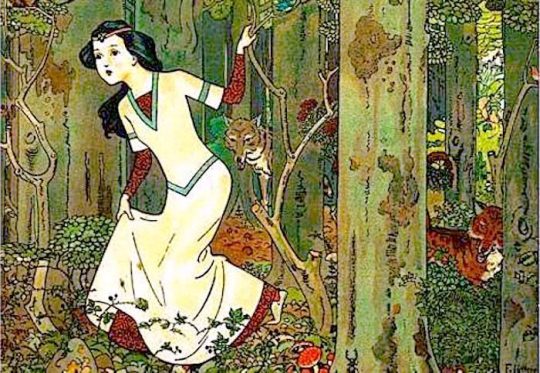
IS SNOW WHITE REALLY A FAIRY TALE?
Snow White is one of the most famous fairy tales for children in the world.
Not only for the version of the Grimm Brothers but also for the 1937 Disney film masterpiece. Like so many traditional tales, it is inspired by German legends. The version that is narrated today dates back to 1857.
The 1812 fairy tale is very different from the one we know: the stepmother is actually the mother of Snow White, who is only 7 years old. She wants to have her killed to eat her liver and lungs with salt and pepper. Her stepmother tries to kill her twice: the first by tightening a belt around her hips until she passes out and the second by giving her a poisoned hair comb. The prince actually sees her for the first time in the glass coffin, and she is awakened by the poison not by a kiss, but by the tugging of the servants who are tired of seeing their angry prince being in love with a corpse. The evil queen dies killed in revenge by Snow White and the Prince, who invite her to their wedding and force her to wear red-hot iron shoes, which first burn her feet, and then force her to dance until she falls dead on the ground. In 1994 a German historian, Eckhard Sander published “Schneewittchen: Marchen oder Wahrheit?”, which translated means: Snow White, is it really a fairy tale?
The scholar supported the thesis that the character of Snow White was inspired by the life of Marghareta Von Waldeck, a German countess born to Philip IV and his first wife in 1533. At the age of 16 the girl was forced by her stepmother, Katharina of Hatzfeld, to move away from Wildungen and go into semi-exile in Brussels. During exile Marghareta fell in love with a prince, the future Philip II of Spain, against the wishes of the family. The relationship was in fact improper and the girl died at 21 years of age, poisoned. According to historians, the girl was killed by assassins of King Philip of Spain, who was also against the relationship between the two boys. The dwarves who help Snow White in the fairy tale are indicated as the children who worked in the copper mines of Philip IV and who lived a life of hard work and fatigue. The poisoned apple also dates back to a historic event in Germany where an elderly man was indicted on charges of giving poisoned apples to children because they had tried to steal some goods from him. According to another scholar, Karlheinz Bartels, Snow White is inspired by the life of Maria Sophia Von Erthal, born on 15 June 1725 in Lohr am Main, in Bavaria, daughter of a landowner, Prince Philipp Christoph Von Erthal and Baroness Von Bettendorff. After the death of his wife, the prince married Claudia Elizabeth Maria Von Venningen, countess of Reichenstain who did not like the presence of stepchildren. The castle where they lived (now a museum) housed a famous talking mirror, a toy that was able to record and reproduce the voice of the speaker (today you can admire it in the Spessart museum), and was a gift from the prince to his second wife. The fairy tale dwarves are tied to a mining town west of Lohr. The galleries could only be reached by very small miners who often wore colored caps, dressed as usually described by the books and cartoons that told the story of the princess. The glass coffin could have been the work of some famous glass factories in the area, while the apple would have been poisoned with belladonna, a plant that grows spontaneously and in large quantities in the parks near the castle.
The stepmother is said to have forced Marghareta to leave the castle, and the girl found refuge in the woods, helped by the miners and where she died of smallpox some time later. The people, learning of the tragic death of the girl, felt aversion against the queen.
The story is very interesting and the reality could be halfway: that is, this story has real bases, a mixture of legends and chronicles of the time that have come down to us today in the form of a fairy tale.
Image: illustration by Franz Jüttner
Note: I started to read online many curious thesis about fairy tales backgrounds and their meanings in psychology. I found those really interesting, I may post some of these also in the future posts! I am going to buy soon a book on this topic! :) meanwhile, I hope you like it!
43 notes
·
View notes
Link
The baroness Maria Sophia von Erthal, whose life may have inspired the Grimm fairy tale. It’s not hard to see how the elements the Grimms added to her story came from alchemy--seven dwarfs, the mine, the apple, the coffin.
21 notes
·
View notes
Photo

La favola di Biancaneve fu tratta da una storia vera (che finora nessuno conosceva) Di Marta Vigneri La vera storia di Biancaneve si discosta molto da quella che conosciamo attraverso il romantico cartone Disney. Secondo alcuni storici tedeschi, infatti, Biancaneve è realmente esistita, ed è a lei che i fratelli Grimm si sarebbero ispirati quando hanno raccontato la storia della principessa, tratta in inganno dalla perfida matrigna e salvata dal principe azzurro e dai sette nani. Holger Kempken è il direttore del museo bavarese che ha affermato di aver ritrovato la lapide del personaggio realmente esistito nel ‘700, a cui s’ispira la storia di Biancaneve. La donna che ha ispirato Biancaneve sarebbe la baronessa tedesca Maria Sophia von Erthal, che viveva nel castello di Lohr am Main insieme al padre e alla sua seconda moglie che, come la perfida matrigna della fiaba, la aveva costretta da allontanarsi per fare spazio ai figli del primo matrimonio. Ma le somiglianze non finiscono qui: il padre della baronessa possedeva una fabbrica di specchi, come quello maledetto della matrigna, e a pochi chilometri dal castello si trovava una miniera dove potevano lavorare solo persone di piccola statura per via dei cunicoli stretti. Insomma, un’immagine che ricorda i sette nani. Infine, lo storico Karlheinz Bartels ha più volte evidenziato che i fratelli Grimm vissero per molto tempo ad Hanau, soli 50 chilometri dal castello di Lohr am Main, dove viveva la baronessa. La sua storia era ben nota nell’Ottocento, perché Sophia aveva perso la vista da molto giovane, perciò secondo lo storico è plausibile che abbia costituito “il nucleo della fiaba di Biancaneve”. A cui però sia i fratelli Grimm che la Disney hanno donato un lieto fine, salvando il personaggio abbastanza sfortunato dalla triste realtà. La Biancaneve realmente esistita, oltre a diventare cieca e ad essere respinta dalla famiglia, morì in un convento. Dove nessun principe azzurro giunse a salvarla....
13 notes
·
View notes
Text
ok so this German town, Lohr am Main, claims that it's the birthplace of the woman who inspired the fairytale of Snow White. (This claim is totally false, the math doesn't add up, I'm working on a blog post series about it.) They have a whole tourist theme based on this.
In like 2013 or 2014, the mayor held a contest for a statue of Snow White to be put up in the town. The judges’ committee picked this as the winner.

It resembles a young child’s endearingly clumsy drawing, but with a kind of Medusa-esque horror. Tentacles protrude from its head. It has buggy, alien-like eyes and a quirky sideways smile like Junior Asparagus. Its stubby T-rex arms and contorted tiny hands are splayed out in a parody of a welcoming embrace. I think it has decolletage?
So since he won, the creator was supposed to make a permanent version. He came back with a big permanent metal version and a 100k euro bill for the town. The townspeople (who apparently did not get any say in the contest) were livid. (Comment from @procrastinatorkimberlygrey: “I FUCKING BET”)
Behold it looming menacingly over the crowd. I like the one woman to the left of the statue who looks like she’s probably crying laughing.
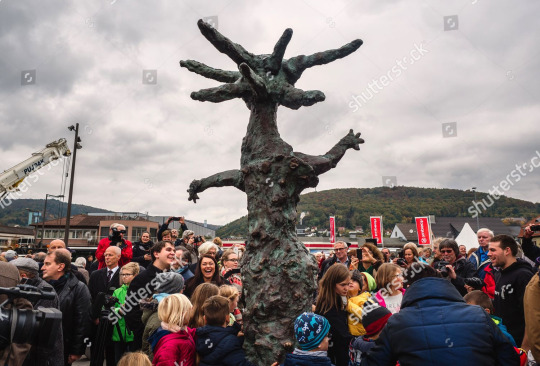
A student put up graffiti of it. Now it’s a meme. They call it “Horror White.” There are T-shirts.

I love everything about this. I’m pretty sure the statue has been vandalized at least once.
9K notes
·
View notes
Note
Hello ! Do you know anything about the history of Philip II and Maria Sophia von Erthal?
Hello! Maria Sophia von Erthal - thought to be an inspiration for Snow White, right? No, unfortunately, I don’t know anything about her. And the only Philip II I have studied is that of Spain. :)
0 notes
Text
What is Killian’s name?
Can we speculate on what Killian’s cused name is going to be. You can see in the trailer that his last name will be Rogers, so lets guess his first name. My guess would be
James (Captain James Hook in Peter Pan)
Here is why i think james might be his name
got this from IMDB trivia for once upon a time. if after reading this you have a better suggestion i would love to hear it because i dont really like the name james for Killian Names for many characters in Storybrooke are often coordinated with their fairy tale counterpart. For example:
Mary Margaret Blanchard (Snow White): Blanchard derives from the French word "blanc" or "blanche" for white. The name "Mary Margaret" is from a real-life woman believed to be the inspiration of the Snow White character named "Maria Sophia Margaretha Catharina Freifräulein Von Erthal" (born on June 15, 1729 in Germany).
Regina Mills (Evil Queen): Regina is a Late Latin and Modern Italian feminine noun and name meaning "queen". Regina's grandfather was a Miller so that is a connection to her last name.
David Nolan (Prince Charming): The masculine name David means "darling" or "beloved." In Biblical text, it is also the name of the shepherd who became King David after defeating the Goliath the giant. Nolan is a Gaelic name meaning "noble," "fighter," or "champion."
Mr. Gold (Rumpelstiltskin): Rumpelstiltskin spun straw into gold in his story.
Ruby (Red Riding Hood): A ruby is a pink to blood-red colored gemstone.
Ashley Boyd (Cinderella): Cinders precede ashes in the burning process. Boyd derives from the Gaelic word "buidhe" meaning yellow-haired.
Sidney Glass (Mirror): Because another word for mirror is glass or looking glass. Also, his newspaper is called "The Mirror." Sidney's character as the Queen's minion trapped in a mirror parallels a genie trapped in a bottle/lamp as a master's servant. The name Sidney refers to Sidney Sheldon, the creator of I Dream of Jeannie (1965).
Archie Hopper (Jiminy Cricket): Crickets often hop to get around. Also, crickets are sometimes called hoppers.
Jefferson (The Mad Hatter): The group Jefferson Airplane has a song called "White Rabbit" which uses lyrics derived from the "Alice in Wonderland" tales.
Paige (Grace): In the real world, the Hatter's daughter is named Paige but in the fairy tale land, her name is Grace. Grace Slick was a member of Jefferson Airplane and writer of their song "White Rabbit."
Dr. Whale (Dr. Frankenstein): In his black and white fairy tale world, he is Dr. Victor Frankenstein. James Whale was the director of the original Universal Frankenstein(1931) and its sequel Bride of Frankenstein (1935).
Cora (The Queen of Hearts): Derived from the Latin word "cor" meaning heart.
Zelena (The Wicked Witch): Zelena means "green" in various Slavic languages.
August W. Booth (Pinnochio): W. Booth references to Wayne C. Booth, who coined the term the "unreliable narrator" i.e. a blatant liar who misleads the audience. August's fairy tale counterpart is known for lying.
5 notes
·
View notes
Photo
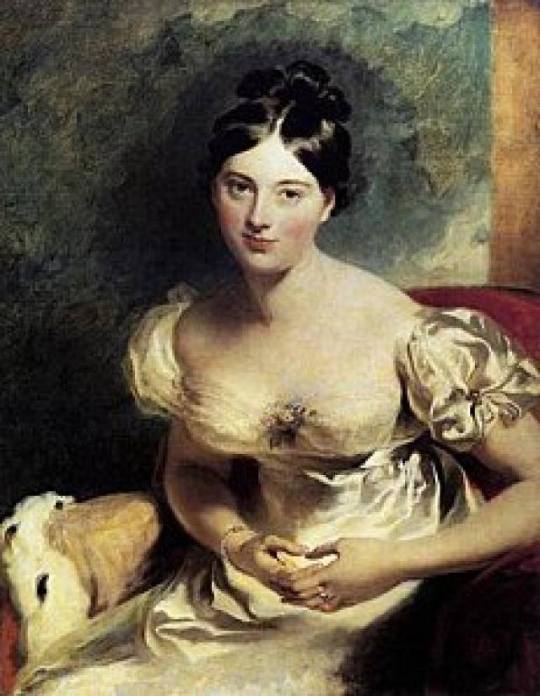
La verdadera historia de “Blanca Nieves y los siete enanos”
Dicen que el filme de Disney es una adaptación del cuento de hadas de los hermanos Grimm pero ¿de dónde tomaron la idea de la hermosa princesa y los enanos?
Sin duda, Blanca Nieves y los siete enanos (Snow White and the Seven Dwarfs, 1937), es una de las películas más importantes de Walt Disney Pictures, pues se trata del primer clásico de animación de la compañía.
Estrenada el 21 de diciembre de 1937, la cinta no fue acreedora a ningún premio de la Academia, pero en 1938, le valió a Walt Disney un Oscar honorífico.
El filme es una adaptación del cuento de hadas homónimo que los hermanos Grimm publicaron en 1812, una historia profundamente arraigada en las tradiciones europeas; pero ¿estos hermanos de dónde tomaron la idea de la hermosa princesa y los enanos?
Existen diversos relatos sobre la verdadera historia de Blanca Nieves, sin embargo, fue el historiador alemán Karlheinz Bartel, quien dedico más de 10 años de su vida en intentar llegar al fondo de esto y sus descubrimientos fueron impresionantes.
Maria Sophia Margaretha Catharina von Erthal es el verdadero nombre de Blanca Nieves, y ¡En realidad existió!, se trató de una pequeña nacida el 15 de junio de 1729 en el pueblo de Lohr y cuya vida, cuenta con todos los elementos del cuento, desde la madrastra hasta los siete enanos, claro sin olvidar el espejo.
Cuando Sophia apenas había cumplido los 12 años, su madre falleció. Dos años después, su padre, condestable del territorio de Kurmainz, se casó con Claudia Elisabeth Maria von Venningen, condesa imperial de Reichenstein. Sin embargo, al parecer la relación entre la joven y su madrastra no era tan mala como la del cuento, si bien la condesa siempre beneficiaba a los hijos de su primer matrimonio y menospreciaba a la verdadera Blanca Nieves, así lo publica ABC.
La pequeña era muy joven, bella y noble, siempre caritativa con las personas necesitadas, por lo que los habitantes del pueblo le tenían muchísimo cariño, y pasaba los días rodeada de niños desnutridos y envejecidos prematuramente por el arduo trabajo que realizaban en las minas de hierro. Estos niños, que vestían largos abrigos y gorros, acabaron convertidos en los siete enanos del cuento.
Y por si fuera poco, dejame decirte que sí, el espejo también existió. Fue un regalo de bodas del padre de Sophia para su segunda esposa, mide más de metro y medio y no habla, pero tiene la particularidad de repetir lo que se diga frente a él debido a un efecto de reverberación. ¿Quieres conocerlo? Puedes encontrarlo en el castillo de Lohr, residencia de la familia reconvertida en el Museo del Spessart.
Finalmente y según información de SuperCurioso, cabe mencionar que un buen día, Sophia falleció. No se saben las causas, pero lo que es evidente es el hecho de que no hubo ni príncipe ni final feliz. Se dice que el ataúd en el que fue enterrada era especialmente distinguido, pues a pesar de que no era totalmente de cristal, poseía algunas piezas talladas por esa industria manufacturera de cristal de la región, que quiso hacerle un homenaje a la joven.
#blancanieves#disney#hermanos grimm#maria shopia margaretha catharina von erthal#espejo#castillo#historia oscura#cristal#enanos#madrastra
2 notes
·
View notes
Text
Biancaneve? una baronessa cieca. A Bamberga ritrovata la vera lapide
Non fu salvata da un principe né visse felice e contenta, ma la sua tragica storia ispirò una delle fiabe più famose dei fratelli Grimm. Il Museo Diocesano di Bamberga, in Germania, ha annunciato di aver ritrovato la lapide di Maria Sophia von Erthal, la baronessa, sorella del potente arcivescovo di Magonza, vissuta nel ’700 […]
Leggi l'articolo completo su Biancaneve? una baronessa cieca. A Bamberga ritrovata la vera lapide
from Fortementein https://ift.tt/33sJjmE
0 notes